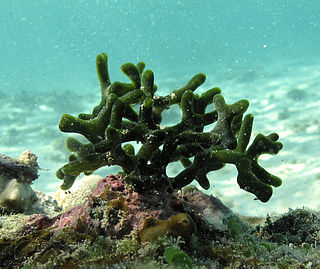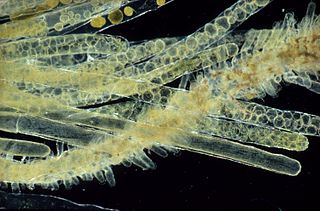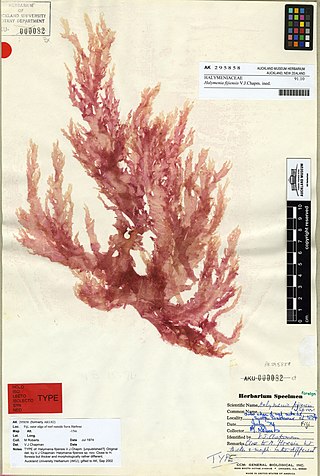
Chlorophyta is a taxon of green algae informally called chlorophytes. The name is used in two very different senses, so care is needed to determine the use by a particular author. In older classification systems, it is a highly paraphyletic group of all the green algae within the green plants (Viridiplantae) and thus includes about 7,000 species of mostly aquatic photosynthetic eukaryotic organisms. In newer classifications, it is the sister clade of the streptophytes/charophytes. The clade Streptophyta consists of the Charophyta in which the Embryophyta emerged. In this latter sense the Chlorophyta includes only about 4,300 species. About 90% of all known species live in freshwater. Like the land plants, green algae contain chlorophyll a and chlorophyll b and store food as starch in their plastids.

The green algae are a group of chlorophyll-containing autotrophic eukaryotes consisting of the phylum Prasinodermophyta and its unnamed sister group that contains the Chlorophyta and Charophyta/Streptophyta. The land plants (Embryophytes) have emerged deep in the Charophyte alga as a sister of the Zygnematophyceae. Since the realization that the Embryophytes emerged within the green algae, some authors are starting to include them. The completed clade that includes both green algae and embryophytes is monophyletic and is referred to as the clade Viridiplantae and as the kingdom Plantae. The green algae include unicellular and colonial flagellates, most with two flagella per cell, as well as various colonial, coccoid (spherical), and filamentous forms, and macroscopic, multicellular seaweeds. There are about 22,000 species of green algae, many of which live most of their lives as single cells, while other species form coenobia (colonies), long filaments, or highly differentiated macroscopic seaweeds.

Charophyta is a group of freshwater green algae, called charophytes, sometimes treated as a division, yet also as a superdivision or an unranked clade. The terrestrial plants, the Embryophyta emerged deep within Charophyta, possibly from terrestrial unicellular charophytes, with the class Zygnematophyceae as a sister group.

Sphaeropleales is an order of green algae that used to be called Chlorococcales. The order includes some of the most common freshwater planktonic algae such as Scenedesmus and Pediastrum. The Sphaeropleales includes vegetatively non-motile unicellular, colonial, or filamentous taxa. They have biflagellate zoospores with flagella that are directly opposed in direction : Sphaeroplea, Atractomorpha, Neochloris, Hydrodictyon, and Pediastrum. All of these taxa have basal body core connections. Motile cells generally lack cell walls or have only a very fine layer surrounding the cell membrane. Other common characteristics include a robust vegetative cell wall, cup-shaped chloroplasts with large pyrenoids, and relatively large nuclei.

Halimeda is a genus of green macroalgae. The algal body (thallus) is composed of calcified green segments. Calcium carbonate is deposited in its tissues, making it inedible to most herbivores. However one species, Halimeda tuna, was described as pleasant to eat with oil, vinegar, and salt.

Viridiplantae constitute a clade of eukaryotic organisms that comprises approximately 450,000–500,000 species that play important roles in both terrestrial and aquatic ecosystems. They include the green algae, which are primarily aquatic, and the land plants (embryophytes), which emerged from within them. Green algae traditionally excludes the land plants, rendering them a paraphyletic group. However it is accurate to think of land plants as a kind of alga. Since the realization that the embryophytes emerged from within the green algae, some authors are starting to include them. They have cells with cellulose in their cell walls, and primary chloroplasts derived from endosymbiosis with cyanobacteria that contain chlorophylls a and b and lack phycobilins. Corroborating this, a basal phagotroph archaeplastida group has been found in the Rhodelphydia.

The Archaeplastida are a major group of eukaryotes, comprising the photoautotrophic red algae (Rhodophyta), green algae, land plants, and the minor group glaucophytes. It also includes the non-photosynthetic lineage Rhodelphidia, a predatorial (eukaryotrophic) flagellate that is sister to the Rhodophyta, and probably the microscopic picozoans. The Archaeplastida have chloroplasts that are surrounded by two membranes, suggesting that they were acquired directly through a single endosymbiosis event by phagocytosis of a cyanobacterium. All other groups which have chloroplasts, besides the amoeboid genus Paulinella, have chloroplasts surrounded by three or four membranes, suggesting they were acquired secondarily from red or green algae. Unlike red and green algae, glaucophytes have never been involved in secondary endosymbiosis events.

Codium is a genus of edible green macroalgae under the order Bryopsidales. The genus name is derived from a Greek word that pertains to the soft texture of its thallus. One of the foremost experts on Codium taxonomy was Paul Claude Silva at the University of California, Berkeley. P.C. Silva was able to describe 36 species for the genus and in honor of his work on Codium, the species C. silvae was named after the late professor.
Oltmannsiellopsidales is an order of green algae in the class Ulvophyceae.

Udoteaceae is a family of green algae, in the order Bryopsidales.

Bryopsis is a genus of marine green algae in the family Bryopsidaceae. It is frequently a pest in aquariums, where it is commonly referred to as hair algae.
Dangemannia is a genus of green algae in the family Oltmannsiellopsidaceae.

Siphonocladus is a small genus of green algae in the family Siphonocladaceae. The algal body (thallus) is composed of long, club-shaped cells that divide by segregative cell division, followed by the formation of branches that break through the mother cell.
Struvea is a genus of green macroalgae in the family Boodleaceae.

Ochrophytes, also known as heterokontophytes or stramenochromes, are a group of algae. They are the photosynthetic stramenopiles, a group of eukaryotes, organisms with a cell nucleus, characterized by the presence of two unequal flagella, one of which has tripartite hairs called mastigonemes. In particular, they are characterized by photosynthetic organelles or plastids enclosed by four membranes, with membrane-bound compartments called thylakoids organized in piles of three, chlorophyll a and c as their photosynthetic pigments, and additional pigments such as β-carotene and xanthophylls. Ochrophytes are one of the most diverse lineages of eukaryotes, containing ecologically important algae such as brown algae and diatoms. They are classified either as phylum Ochrophyta or Heterokontophyta, or as subphylum Ochrophytina within phylum Gyrista. Their plastids are of red algal origin.
The Rhodogorgonales are an order of red algae, a sister group to the corallines. They are always thalloid and calcified; their calcification is very different from the corallines, as individual calcite crystals are deposited in the cell wall of specialised cells; this suggests that the evolution of calcification may have been independent from the corallines. They have no fossil record.

The Phragmoplastophyta are a proposed sister clade of the Klebsormidiaceae in the Streptophyte/Charophyte clade. The Phragmoplastophyta consist of the Charophycaea and another unnamed clade which contains the Coleochaetophyceae, Zygnematophyceae, Mesotaeniaceae, and Embryophytes. It is an important step in the emergence of land plants within the green algae. It is equivalent to the ZCC clade/grade, cladistically granting the Embryophyta.

Dictyota is a genus of brown seaweed in the family Dictyotaceae. Species are predominantly found in tropical and subtropical seas, and are known to contain numerous chemicals (diterpenes) which have potential medicinal value. As at the end of 2017, some 237 different diterpenes had been identified from across the genus.
Pseudorhizoclonium is a genus of algae in the Cladophoraceae family.

Halymeniales is an order of red algae belonging to the class Florideophyceae and the subclass Rhodymeniophycidae.















